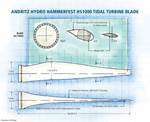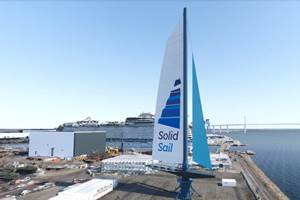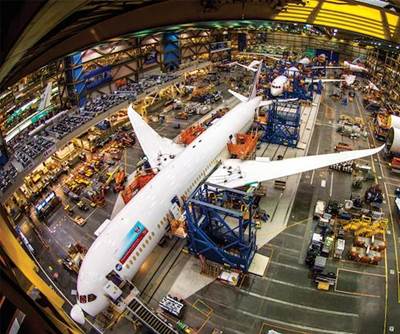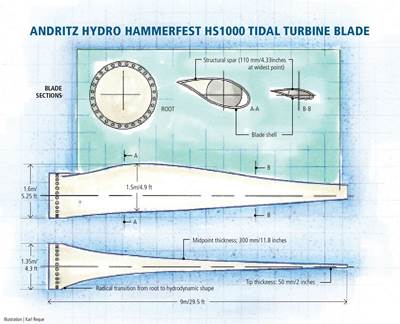Structural adhesives, Part I: Industrial
Today’s myriad chemistry options enable formulators to tailor adhesives to customers' exact application requirements.
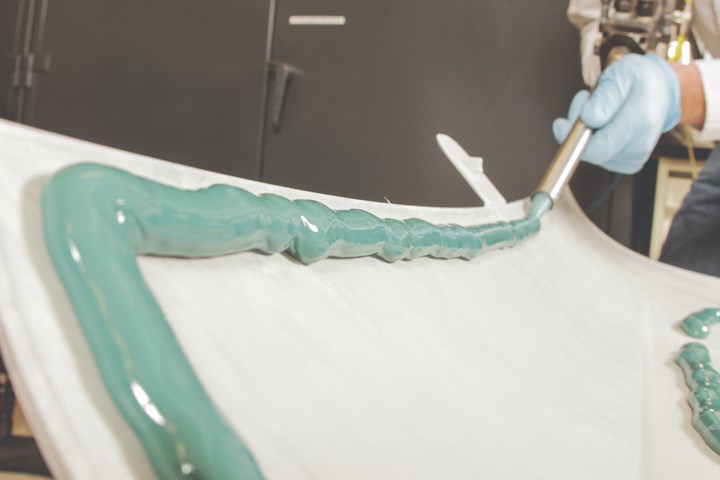
Adhesive vs. fasteners. Adhesive bonding of composites, to like and unlike materials, without the use of mechanical fasteners, enables manufacturers to eliminate hole drilling and leverage cascading benefits of weight and cost savings throughout larger assembled structures. Perhaps most important, it can significantly shorten production cycle, a critical goal in automotive assembly operations such as the one pictured here, using Pliogrip structural adhesive from Ashland Performance Materials (Columbus, OH, US). Source | Ashland
Fasteners always will have a place in manufacturing assembly, but one of the Holy Grails of composites manufacturing is adhesive joinery that eliminates mechanical fasteners. Relieved of fastener weight, much lighter bonded composites could be leveraged for cascading weight and cost benefits elsewhere in the larger structures of which they are a part. Further, with no fastener holes, those composites would deliver better fatigue performance. Perhaps most important, elimination of drilling operations would accelerate manufacturing cycle time, ensuring lower overall cost even if the adhesive’s material cost were greater than the cost of the fasteners it replaces.
Although redundant fasteners are mandated in adhesively bonded commercial aerospace structures — a situation unlikely to change in the near future (see “Structural Adhesives, Part 2: Aerospace”) — fabricators in marine, wind energy and other “industrial” market sectors have enthusiastically embraced adhesive-only bonding. Many more applications from architecture to automotive stand to benefit from advances in bonding technology.
The result has been rapid, long-term growth in the development of structural adhesives. The worldwide market for all types of adhesives exceeds US$45 billion, with 8% annual growth predicted by research firm Markets and Markets (Pune, India). According to Structural Adhesives: Chemistry and Technology author S.R. Harts- horn, structural thermosetting adhesives comprised 10-15% of the total adhesives market in 2015, and were posting annual growth rates of 7-9% as early as the 1980s. Meanwhile, the Freedonia Group (Cleveland, OH, US) says global demand for adhesives and sealants is forecast to grow 4.5% per annum through 2019 to 20.2 million MT. Conservatively, then, the structural adhesives market could be worth US$4.5 billion, today, and US$6 billion-$7 billion by 2020.
Getting the glue right
At least 40 adhesives suppliers now serve the composites industry (see CW’s Tech Table: Adhesives for our most recent aggregation). Although structural adhesives offer an opportunity to simplify assembly of manufactured products, it is no simple matter to arrange that opportunity either for those who formulate them or for the molders who must find a formula to match a particular composites application.
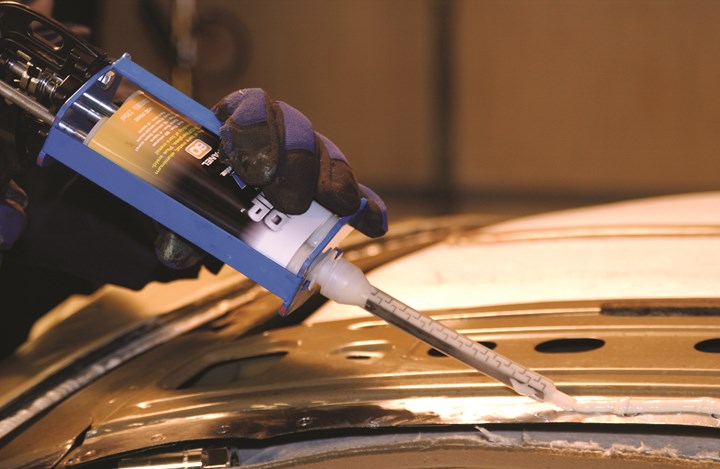
Truck-hood tough bonding. Ashland’s (Columbus, OH, US) Pliogrip polyure- thane, epoxy and acrylic chemistries, are already used to bond most Class 8 truck-hood and raised-roof assemblies, and, in automobiles, to bond composites for roofs, doors, hoods and lift gates. Source | Ashland
“Adhesives mean chemistry, and chemistry is complex,” emphasizes George Bullen, president and CEO of Smart Blades Inc. (Oxnard, CA, US). Formerly with Northrop Grumman and a Fellow in the Society of Manufacturing Engineers (SME), he points out, “Many factors need to be considered before undertaking structural bonding of composite materials.”
Making and selecting adhesives has, historically, involved formulation and applications tradeoffs that can prove challenging. For example:
- Tougheners added to improve elongation and impact resistance can reduce adhesive strength and glass transition temperature (Tg).
- Heat during fixturing and cure might be needed for best results, particularly with epoxies, but also can contribute to bond line read-through in bonded assemblies, in which the adhesive bonds within the assembly can be detected on the outer cosmetic surface. Room-temperature cure is less susceptible to read-through but, historically, less efficient.
- When bonding dissimilar materials, the adhesive’s formulation must accommodate potentially significant differences in coefficients of thermal expansion (CTEs) and surface properties of the bonded components.
- Surface preparation and cleaning prior to adhesive application, fixturing and cure optimizes joint adhesion but can significantly prolong processing time and increase per-part cost.
- On a joint with a large surface area, such as a boat hull, longer open-time or out-time will be required, yet the additional out-time has the potential to degrade the adhesive’s cured mechanical properties.
- If the surface to be bonded during assembly is oriented vertically, the adhesive must have enough sag resistance to remain where placed. Notably, adhesive suppliers are reporting a number of recent product developments that mitigate or circumvent such difficulties, offering customers an unprecedented degree of design freedom.
Automotive “multi-material” applications
A key property required in automotive structural adhesives is elongation, necessary to accommodate CTE differences and the movement of body parts in relation to each other under dynamic and fatigue loading on the road. And as the “multi-material vehicle” mantra spreads in the auto industry, composite-to-metal bonding has become a necessity. The adhesives that meet this requirement must accommodate significant differences in the materials. Key innovations here also include adhesives that cure rapidly and require little-to- no surface preparation.
Dow Automotive Systems (Auburn Hills, MI, US) revealed in 2014 that its trademarked BETAFORCE urethane composite bonding adhesive is being used by BMW Group (Munich, Germany) to bond the carbon composite elements of the all-electric BMW i3 car (Read about the BMW i3 in “BMW Leipzig: The epicenter of i3 production”). The urethane offers a balance of strength, flexibility and good adhesion to multiple substrates, and a very high elongation. It has a unique two-part, pre-polymer chemistry, which means that some of the diisocyanate is already reacted with the polyol to create an intermediate, partially reacted polymer with higher molecular weight for better mixability and stability. Dow Automotive’s Christophe van Herreweghe, adhesive market manager, says, “BETAFORCE, depending on the specific grade, has a modulus varying from 20 MPa to 300 MPa and an elongation as high as 400% for superior energy absorption under dynamic and fatigue loading.”
Van Herreweghe says that previous grades of BETAFORCE required a primer coat or application of an activator, but the latest grade does not. Although any mold release that remains on the composite parts must be removed prior to bonding, he emphasizes that BETAFORCE bonds well to composites. After adhesive is dispensed via automated meter/mix machine, cure occurs with application of heat, typically infrared or other rapid method, to more than 80°C for 1-3 minutes to achieve handling strength.
Dow Automotive is currently working on expanding the adhesive’s open time, in combination with faster cure via heat acceleration. “We’re researching more sophisticated application technologies,” he adds, “such as bead injection into cavities for bonding composites to metal frames, and new encapsulated formulations for spot curing under heat acceleration.”
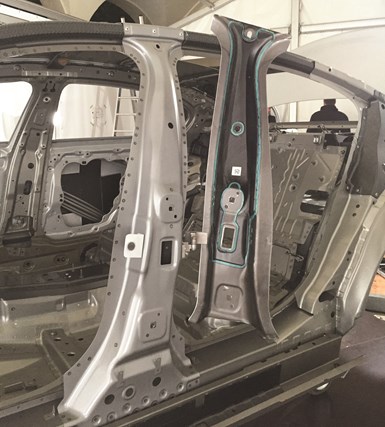
Bonding the BMW 7-Series B-pillar. L&L Products (Romeo, MI, US), developed a customized epoxy film adhesive for BMW (Munich, Germany), for use in bonding a carbon fiber stiffener to metal inside its new 7-Series B-pillar. The adhesive performs multiple functions, including galvanic isolation). Source | L&L Products
Another BMW adhesives supplier, L&L Products (Romeo, MI, US), which entered the automotive/commercial vehicles market with noise, vibration and harshness (NVH) products, already has a composite-to-metal adhesive in serial production. A custom formulated, heat-activated, toughened epoxy film adhesive is used to bond a carbon/epoxy composite structural stiffener to the inside of the BMW 7-Series steel B-pillar. “The adhesive cure can be as high as 190°C for a sub-1-minute cure time,” explains Didier Trau, project manager of advanced development at L&L’s Molsheim, France, facility. “However, for the BMW process, cure is tailored to match the cure profile of the carbon prepreg, and still achieves a 2-minute cure.” The film is cut to shape, preformed with the carbon prepreg and cures in the compression molding process that shapes the stiffener (see photo at right).
Trau notes that no surface preparation is required for either the metal or the prepreg material, saving considerable time. The film’s elongation accommodates differences in thermal expansion between the composite and the steel. A key point, adds Trau, is that the film includes an embedded glass veil that ensures consistent separation between the carbon prepreg and the steel substrate, to avoid galvanic effects: “If we used microspheres for bondline control, there is the chance that stray fibers of carbon might still contact the metal. The veil ensures a complete separation, yet guarantees the minimum bondline thickness.”
SCIGRIP Smarter Adhesive Solutions (an IPS company, Durham, NC, US, and Tyne and Wear, UK) supplies acrylic structural adhesives to a number of transportation customers, among them GRP HighTech (Bangkok, Thailand), which uses SciGrip’s SG5000 1:1 high-performance methyl methacrylate (MMA) for bonding fiber- reinforced acrylonitrile butadiene styrene (ABS) rear spoilers and front skirt parts to a metal substructure for major auto OEM customers, including Toyota (Tokyo, Japan). SG5000 reportedly has excellent adhesion to the ABS parts and the stainless steel supports to which they’re bonded because acrylics form strong covalent bonds that provide high tensile strength yet also exhibit high elongation (up to 150%) to adjust to variations in CTE. More importantly, its fast room-temperature cure with little or no surface preparation — MMAs are generally suitable for applications involving moderate temperatures (80-100°C) — matches production speed, says Mark Rogan, SciGrip’s European sales and marketing manager.
“SciGrip offers its products in two ways: in a 1:1 mix ratio paste for typical transport and industrial applications. Its 10:1 mix ratio paste products, with a peroxide-based activator, provide higher performance on more diverse substrates, delivering up to 150% elongation and up to 90% of the strength of epoxy,” says Rogan. SciGrip SG230HV (high viscosity) and SG300, both intended for high-production-rate vehicle manufacturing, are 10:1 mix ratio products, used often for composite-to-metal bonding, with higher temperature resistance than the 1:1 products: “SG300 requires no surface preparation before bonding and gives very good fatigue performance,” he adds.
3M (St. Paul, MN, US) offers a range of epoxies built on legacy Scotch-Weld chemistry pioneered and trademarked for composites more than 30 years ago, says Brent White, 3M’s global structural adhesives manager. 3M Scotch-Weld two-part 420NS epoxy offers good fatigue performance and can withstand automotive E-coat and powder-coating temperatures.
“Customer needs have led to our team’s development of polyurethane adhesives, such as 3M Scotch-Weld urethane adhesive 620,” adds White. “They’re very effective where flexibility is needed, such as in composites/metal bonds.” The adhesive has a low dispense viscosity, yet is non-sagging after dispensing and provides low temperature flexibility.
Ashland's (Columbus, OH, US) trademarked Pliogrip structural adhesives — available in polyurethane, epoxy and acrylic chemistries — have been employed for more than 40 years in automotive and heavy truck applications. “Our Pliogrip 9100 two-component heat cure urethane ... is capable of achieving a heated fixture time as short as 2 minutes, with little or no surface preparation,” contends Keith Grover, Ashland’s industry manager for structural assembly adhesives. “The tailored cure helps to maximize our customers’ productivity.” A second adhesive, Pliogrip 8500, offers a room-temperature cure option. Because urethanes degrade at high E-coat process temperatures during vehicle painting, Ashland also offers Pliogrip 5500 two-component epoxy. It provides an open time of 30 minutes and a 2-minute heated fixture cure that can withstand 205°C, for applications that will be post-painted. Pliogrip products are used to bond most Class 8 truck hood and raised roof assemblies, and, in automobiles, to bond composites for roofs, doors, hoods and liftgates.
Pliogrip products are designed to reduce or eliminate surface prep and to streamline production. But Grover adds that the selected adhesive should be qualified to ensure it meets the performance requirements for the application, a process that Ashland can assist the customer with, in its laboratory. “Lightweighting is a hot trend in many markets,” he sums up, “and we’re developing new products capable of minimizing part distortion, joining dissimilar substrates and curing at even faster speeds to enable high-volume production rates.”
LORD Corporation (Cary, NC, US) also supplies a portfolio of epoxy, urethane and acrylic adhesives for a range of markets including vehicle metal bonding, and is a supplier to bus and commercial truck OEMs, says Julie Miller, LORD’s global market manager. Although Lord’s 200- and 400-series acrylics are general-market adhesives, its 600-series provides extended working times for large parts, such as “big rig” fairings. The adhesive also can form large beads where large bond gaps exist, and can accommodate composite-to-metal bonding.
“Our newer 800-series acrylics are specifically designed to reduce or eliminate bondline read-through,” adds Dr. John Hill, principal engineer, structural adhesives R&D, who explains that read-through is a not yet fully understood phenomenon. LORD’s urethane grades, used for automotive and heavy-duty truck assembly, include 7542 and 7545: 7542 is a low-viscosity liquid that allows gravity feed, yet offers instant sag resistance when applied to vertical surfaces, thanks to its chemical thixotropy (7545 has similar properties but comes as a paste). For higher temperature applications, LORD offers a range of epoxies.

Solar-powered car chassis assembly. Permabond’s (Colden, Hampshire, UK and Pottsdown, PA, US) MMA product TA4810 is used by Western Michigan University’s Sunseeker solar-powered car project techs to assemble the complex composite chassis of Nomex-cored carbon/epoxy prepreg panels. The adhesive’s thick, non-sag bondline was easy to control, and cured within 15 minutes, eliminating the need for elaborate fixtures. Source | Western Michigan University/Permabond
With a long history of engineering adhesive development, Permabond (Colden, Hampshire, UK and Pottsdown, PA, US) serves virtually all markets and offers a large range of adhesive chemistries in liquid and paste form. A recent application of Permabond’s MMA product TA4810 is on the Western Michigan University’s Sunseeker solar-powered car project, headed by WMU senior Cameron Tyler Knight.
Knight says that the 2016 Sunseeker car is under construction now, and that the complex composite chassis is made with Nomex-cored carbon/epoxy prepreg panels that are waterjet cut to shape. To bond the car’s chassis components, Permabond’s MMA adhesive provides a thick, non-sag bondline that’s reportedly easy to control, curable within 15 minutes and eliminates the need for elaborate holding fixtures. “Our previous epoxy adhesive required fixturing,” says Knight, “but with the Permabond MMA, we can virtually hold the components in place while the adhesive sets. A big part of our success in solar racing is using strong adhesives in the right places.”
Marine, construction and more
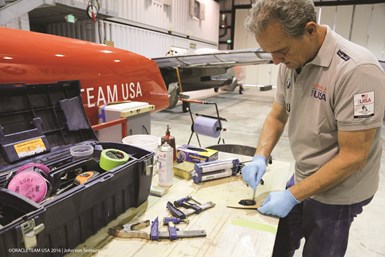
Adhering to excellence in yacht racing. Ian Burns, performance team manager for ORACLE TEAM USA (San Francisco, CA, US), says his yachtbuilding team uses PRO-SET epoxy adhesives (Gougeon Bros., Bay City, MI, US) to build high-quality small parts, which are eventually joined to elements of the team’s racing vessels. The pre-thickened, two-part structural pastes, based on resins and hardeners that do not require elevated-temperature post-cure, reportedly achieve good adhesion and mechanical properties on a great variety of substrates. Source | ORACLE TEAM USA
One arena in which structural adhesives have established a solid niche is competition yacht building. “America’s Cup racing catamarans are built with methods comparable to processes used in the aerospace industry today,” says Jimmy Spithill, ORACLE TEAM USA’s (San Francisco, CA, US) skipper and helmsman, yet without that industry’s requirement to use redundant mechanical fasteners. “The boats must be extremely light, yet stiff and strong enough to take real punishment on the water, and PRO-SET adhesives are like the ‘nuts and bolts’ that make our builds possible.”
Ian Burns, ORACLE’s performance team manager, says the team uses PRO-SET adhesives to build very high-quality small parts, which are eventually joined to the boat. Made by Gougeon Bros. (Bay City, MI, US), PRO-SET adhesives are pre-thickened, two-part structural paste epoxies, based on resins and hardeners that do not require elevated-temperature post-cure to achieve good adhesion and high mechanical properties on virtually any substrate, says the company. Depending on the hardener selected, working out-time can range from 20 minutes to 150 minutes at room temperature, and PRO-SET’s “shear thinning technology” reportedly enables users to dispense paste easily by hand, or via powered dispensing equipment, through static mixing nozzles. For best results, says technical director Jeffrey Wright, faying surfaces should be cleaned with a solvent to remove contamination, then abraded.
Elsewhere in the marine market, 3M’s recently developed two-part acrylic adhesive, says Shari Loushin, the company’s structural adhesive lead technical service specialist, is specially formulated to bond to many low-surface-energy plastics, including polyolefin, polypropylene, polyethylene and thermoplastic elastomers, all of which are notoriously difficult to bond without surface preparation. “Structural plastic adhesive 8010 Blue can bond dissimilar substrates in the same application, replacing mechanical fasteners and plastic welding,” contends Loushin.
3M customer Aqua-Cal (St. Petersburg, FL, US) made the switch to 8010 Blue, replacing sonic welding. The company produces pool heat pump condensers molded with 40% glass-filled polypropylene, in a barrel shape with domed top and bottom. Plant manager Jason Taghikhani says Aqua-Cal has gone from a 40-50% failure rate using welding to less than 2% failure, using adhesive to bond the condensers together: “Our laboratory testing shows that with the 8010 Blue adhesive, the polypropylene breaks before the adhesive, which is proof of a great bond.”
Scott Bader Company Ltd.'s (Wollaston, Northamptonshire, UK) trademarked Crystic Crestomer is a hybrid urethane/acrylic that also was developed originally for the marine market, first used to replace titanium rivets on Sandown-class naval minesweeper vessels in the British navy. All Crestomer variants have earned approvals from several maritime classification societies. Jon Stowell, Scott Bader’s global business leader for adhesives, says, “The ability of MMAs and urethane/acrylates to bond dissimilar substrates has broadened their acceptance in many industries, beyond composites, and we’re conducting research to widen the number of bondable substrates.”
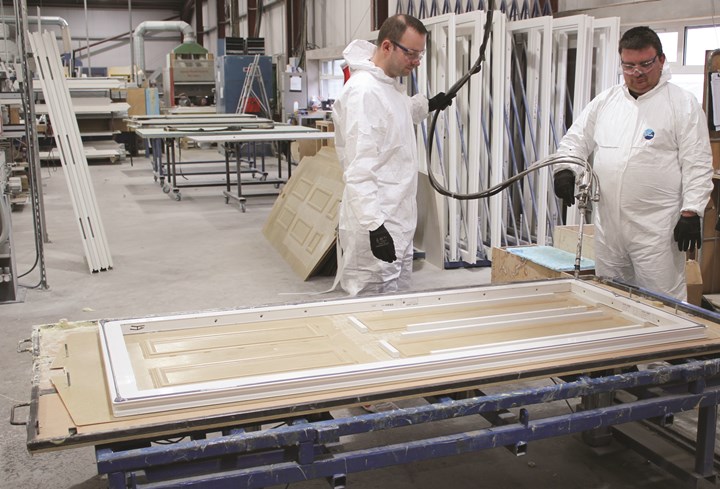
Automation increases application speed. New World Doors (Ballymena, Northern Ireland) has reduced its cycle time by 73% for its inner door sash bonding step, and significantly increased adhesive application speed through the use of an automated dispensing machine. Scott Bader (Wollaston, Northamptonshire, UK) supplies the adhesive: Crystic Crestabond M1-05 10:1 methyl methacrylate (MMA). Source | Scott Bader
In the construction arena, Scott Bader’s Crystic Crestabond M1-05 10:1 MMA adhesive is preferred by New World Doors Ltd. (Ballymena, Northern Ireland) to bond its molded composite door components, including the inner sash frame and door skins (see fourth photo down, at left). The company has reduced its cycle time by 73% for the inner sash bonding step, and significantly increased application speed with automated dispensing equipment. Asa McGillian, New World’s managing director, says, “With the fixture time of 12 minutes that Scott Bader provides, we have made significant productivity gains. Part quality has improved as well, particularly during colder weather periods, because of the consistency of the Crestabond — we’ve less scrap and fewer breakages compared to the adhesives we used previously.”
Crystic Crestabond is one of two groups of structural adhesives Scott Bader manufactures for a wide range of markets. Crestabond MMAs are modified using proprietary chemistry for a unique set of properties, says the company, and 1:1 or 10:1 mix ratios are available, in a wide range of working times (3-100 minutes). Crestabond bonds composites, metals, plastics and dissimilar substrates, with no primer needed and minimal surface cleaning. However, peel ply (without silicone lubricants) is recommended to keep composite surfaces clean and ready to bond.
Gurit's (Newport, Isle of Wight, UK) Spabond structural epoxies are well known for performance in marine, industrial and wind blade applications. Developed initially for marine hull-to-deck bonding, the Spabond range includes 2:1 and 1:1 mix ratio products that cure overnight, or 5-minute fast-curing formulations, says Ian Lancey, Gurit’s formulated product manager: “All Gurit Spabond adhesives are designed primarily for bonding of epoxy-based composites, in hand layup, RTM and infusion processes. They will bond well to most composites as well as metals.”
Gurit’s Spabond SP340LV toughened epoxy adhesive formulation was chosen for its high strength, ease of application and resistance to saltwater for assembly of the blades used on the Andritz Hydro Hammerfest (Scotland) tidal turbine rotor, the largest single tidal turbine installed to date.
A wealth of additional applications
Venkat Nandivada, manager of technical support at epoxy adhesives specialist Master Bond Inc. (Hackensack, NJ, US), says his company’s niche is customized formulations for demanding applications. “We pride ourselves on tweaking formulations based on conditions, processing demands and packaging requirements involved,” he says. “We can modify viscosity, working time/cure time, hardness/modulus, and temperature resistance, to name a few.”
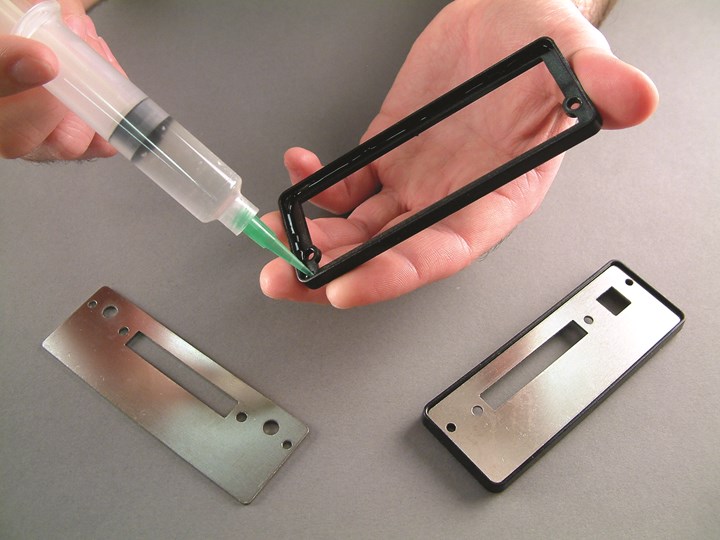
Selective conductivity. A research focus at Master Bond (Hackensack, NJ, US) is development of thermally conductive epoxies that function at thicknesses as thin as 10-15 microns (0.0004 to 0.0006 inch), so that less adhesive is required without compromising part functionality. A new series of thermally conductive, electrically insulating structural epoxies applied in ultra-thin bond lines, in parts such as those pictured here, is designed to maximize heat transfer. Source | Master Bond
A research focus at Master Bond, says Nandivada, is developing thermally conductive epoxies (see photo below) that function at thicknesses as thin as 10-15 microns (0.0004 to 0.0006 inch): “The goal is to use less adhesive, which reduces the carbon footprint of the part, without compromising functionality. We have a new series of thermally conductive, electrically insulating structural epoxies applied in ultra-thin bond lines that help maximize heat transfer.” A recent case involved carbon fiber parts that had to be bonded in two configurations: the first required a low-viscosity liquid, while the second needed a thixotropic paste, applied via syringe. Both had to withstand cryogenic temperatures, and be low outgassing. “Our two-part EP29LPSP heat- curing, low-viscosity resin handled the first configuration, while one-part SUPRE- ME10AOHT-LO worked in the second,” he notes, adding, “Both products meet NASA out-gassing specifications and are cryogenically serviceable.”
Royal Adhesives & Sealants (South Bend, IN, US) specializes in MMA chemistry, but also manufactures and sells epoxy and polyurethanes through some well-known brands, says Dr. Richard Foukes, Ph.D., Royal’s VP of technology: “Tailoring and ‘tuning’ high-performance, specialized adhesives is what we do best. We custom-formulate for an application, rather than requesting a customer adjust preparation or change a substrate.” Adhesives for severe working environments are a specialty, he adds, those with excessive vibration, shock and impact.
Royal is involved in a number of co-research projects with key customers. One involves MMA that can withstand impact at -51°C, yet maintain bond integrity and flexibility. Another is a project to move its Korapur 4W polyurethane adhesive into wind blade assembly, with an automated dispensing system to significantly reduce cycle time, which Foukes says is a “huge industry issue.”
ACRALOCK MMA adhesives, from Engineered Bonding Solutions LLC (Titusville, FL, US), were used to build a marine dock along the St. Johns River in Jacksonville, FL. Jacksonville Fire & Rescue Department (JFRD) Station 40, designed by George Register of Register Marine (Jacksonville, FL, US), is an all-composite structure that can resist Category 3 hurricane winds. Explains Register, “We developed a system where all of the composite pultrusions are held together using both ACRALOCK structural adhesive and stainless steel through-bolts.”
The ACRALOCK MMA successfully bonded glass-reinforced polyurethane and glass/polyester structural elements used on the project, which was completed on schedule in 2013 and within a tight budget. ACRALOCK designs its two-part MMAs for tough applications in bus, truck, rail, marine, architectural and other “industrial” projects. In the future, Register would like to eliminate the fasteners on similar projects, but the structural redundancy they provided was, he says, necessary to appease the structural engineer on the dock project.
Adhering to a growth trajectory
So, what’s the future for structural adhesives? Certainly, the trend toward customer- and application-specific products will continue. “These adhesive products enable engineers to optimize part design for better production and more intelligent assembly,” concludes Ashland’s Grover, “We foresee a continued increase in adhesive use as an enabler for composites in many market spaces.”
But Smart Blades’ Bullen cautions, “The best adhesive in the world won’t work well if it’s not applied correctly by the people involved in the process. To crack this nut, we need more auto- mated application processes and better quality control.”
“The composites industry is in need of effective bonding solutions as customers look to specify more and more lightweight composite materials,” 3M’s White sums up, noting that adhesive suppliers need one particularly important ingredient, that of feedback: “We look to those customers to inspire our innovation.”
Read more in “Structural Adhesives, Part II, Aerospace.”
Related Content
Alliance for European Flax-Linen and Hemp reports increasing flax fiber adoption in marine
The natural fiber is increasing traction across several marine applications, including in projects by Greenboats, Northern Light Composites, the Beneteau Group and others.
Read MoreThe lessons behind OceanGate
Carbon fiber composites faced much criticism in the wake of the OceanGate submersible accident. CW’s publisher Jeff Sloan explains that it’s not that simple.
Read MoreRevisiting the OceanGate Titan disaster
A year has passed since the tragic loss of the Titan submersible that claimed the lives of five people. What lessons have been learned from the disaster?
Read MoreChantiers de l’Atlantique reveals 66-meter, all-composite SolidSail mast
A technological feat, the large carbon fiber mast prototype targets the Silenseas sailing liner and sailing cargo ships for up to 40% reduction in CO2 emissions.
Read MoreRead Next
Structural adhesives, Part II: Aerospace
Tried-and-true legacy epoxies are a must for aerospace composites, but usage is increasing with improved forms.
Read MoreTidal turbine blade toughened for turbulent salt sea
Demonstrator design proves robust blade destined for 10-MW tidal turbine farm.
Read MoreBMW Leipzig: The epicenter of i3 production
A glimpse into the inner workings of an automaker at the forefront of serial-production autocomposites.
Read More


